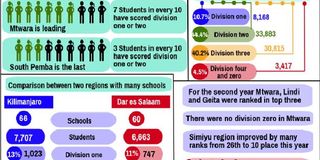Understanding Form Six regional results puzzle

What you need to know:
Form Six national results regional performance ranking released by National Examinations Council Tanzania (Necta) shows that 68 per cent of students who completed their studies in that region scored either division one or two.
Seven out of ten students who completed their Form Six education in Mtwara region will continue with higher education level.
Form Six national results regional performance ranking released by National Examinations Council Tanzania (Necta) shows that 68 per cent of students who completed their studies in that region scored either division one or two.
The results show that no student scored division zero in Mtwara region. The region was also ranked first in Form Six national examinations (ACSEE) this year and third last year.
Mtwara Regional Education Officer (Reo) Germana Mung’aho, told Success that good and supporting education infrastructures makes it easy for teachers to teach well and for students to easily understand.
Analysis by Success has also established that 64.6 per cent and 63.6 per cent of students in Lindi and Geita scored division one or two and hence will continue with their higher education. The two regions have also ranked second and third respectively.
For the second consecutive year Mtwara (first), Lindi (second) and Geita (third) have dominated the top three places with the latter ranked first in 2017, Lindi maintained its second place and Mtwara was third.
Generally, five out of ten students scored division one or two national-wise to make a total of 42,051 (55.1 per cent) of 76,283 candidates who have qualified to continue with higher education.
Other regions with at least six out of ten students who have scored division one and two were Morogoro with 61.6 per cent , Tanga 60.4 per cent, Singida 61.2 per cent and Manyara 60.6 per cent.
Kilimanjaro, which had many schools (67 schools) and many students (7,707) who finished their form six exams in 2018, led with many students who scored division one and two. There were 1,023 students with divisions one and 3,490 students with division two.
The region had 71 students with division zero (4.7 per cent) of all students in that year. The region was also ranked 6th this year, one place higher than last year.
The case in Kilimanjaro is contrary to that of Dar es Salaam, which had 60 schools (second most) and 6,663 students (also second most), but only 47 students out of 100 students scored division one and two (747 division one and 2,360 students with division two). This is less than that of Kilimanjaro.
Kilimanjaro regional commissioner Anna Mghirwa told Success that competitive mind among students and well organized teaching staffs in her region is the reason for their good performance.
“Competition among schools in this region and well-motivated teaching staffs is our success, “ she said, adding that they motivate their teachers by providing them incentives and seminars to build their capacity.
Dar es Salaam had 199 division zero students, which is equivalent to 2.9 per cent of all students who sat for the exams in that region.
The data further shows that in every ten students who scored division zero in the country, two of them are from Dar es Salaam.
Dar es Salaam, which was ranked last (26th place) in mainland Tanzania has dropped six places compared to last year’s results (20th place).
Apart from that, there were twelve regions which were below the national average of 55.1 and five regions have the average of less than 50 per cent.
This means more than five students in every ten students in those regions have lower possibility of continuing with their higher education, save those who scored division three.
The five regions were Mara which has 49.2 per cent, Dar es Salaam with 46.6 per cent, Zanzibar west 35.2 per cent, North Pemba 32.2 per cent and South Pemba with 32.6 per cent. The five regions have also ranked the last; 25th to 29th respectively.
According to data, more than 50 per cent of students in Mara region scored from division three to zero and only 49 per cent have division one or two.
Ranking results show regional performance has dropped, but there is an improvement in regional mobility performance.
Dar es Salaam region, which registered two schools in the top ten (Feza boys and Feza Girls) has ranked 26 from 20th place the previous year. This was attributed to poor performance of some schools in the region, including Jangwani secondary school, ranked 541th out 543 schools regional wise.
Contrary to Dar es Salaam, Coastal region which has registered four schools in the top 10 (Kibaha, Marian Boys, Marian Girls and Ahmes school) upgraded by 4 positions to 19th place from 23rd place in the previous results.
Antony Mulokozi, 20, who emerged as the best student in this year’s exams told Success that his performance was mainly due to studying hard and good cooperation with teachers and his fellow students.
Mulokozi, who completed his studies in Kibaha Secondary school, taking PCB combination, has a desire to become a doctor one day.




